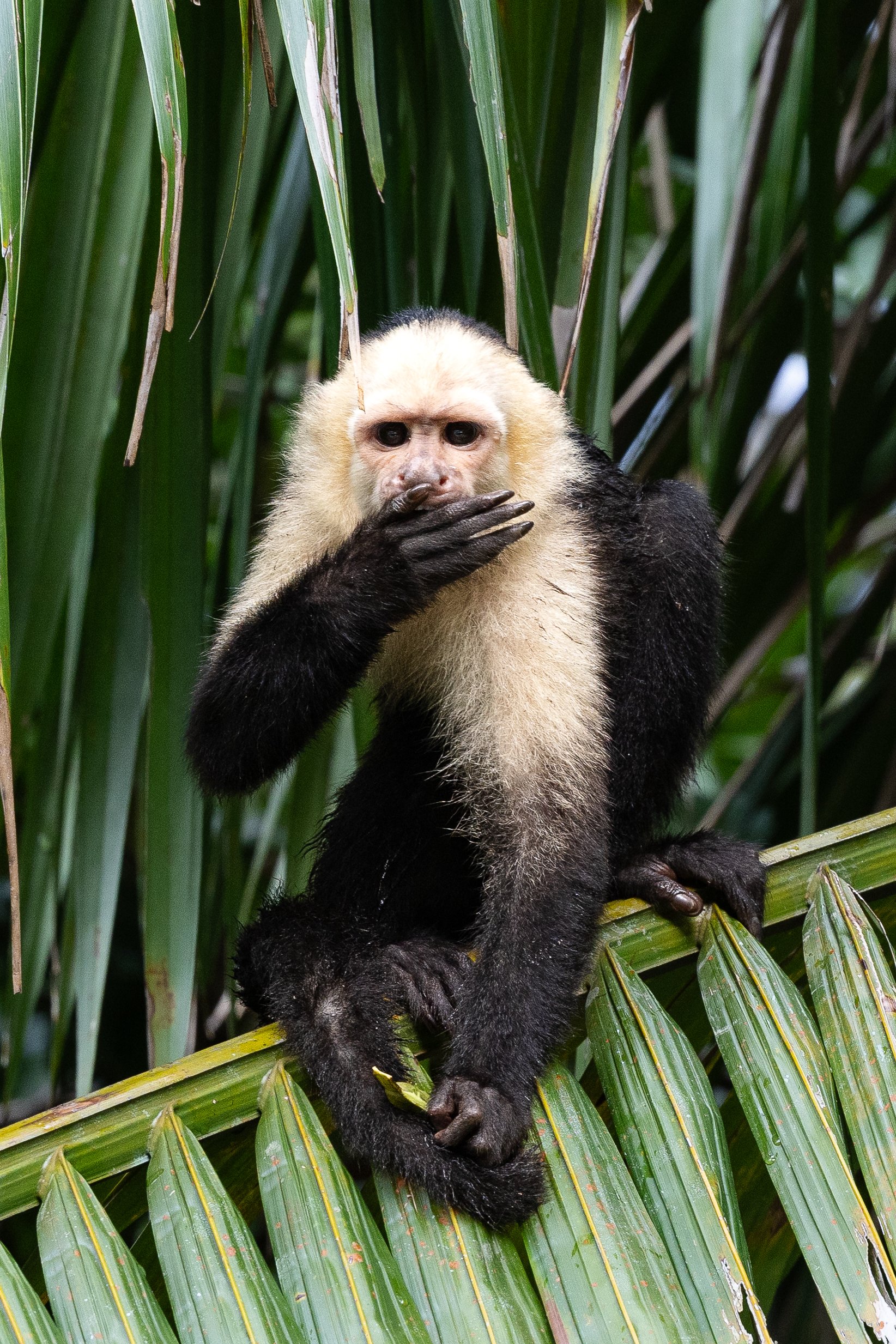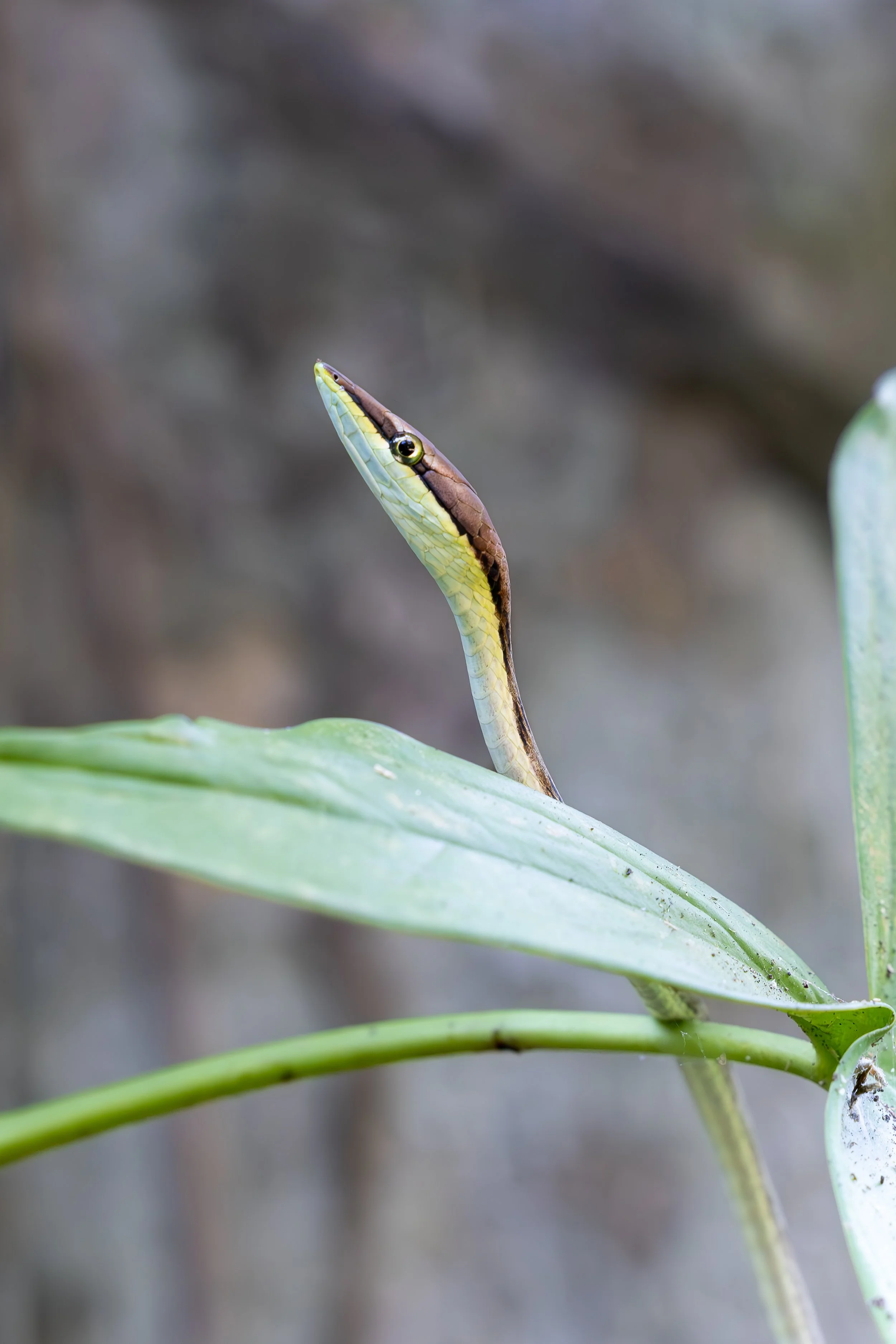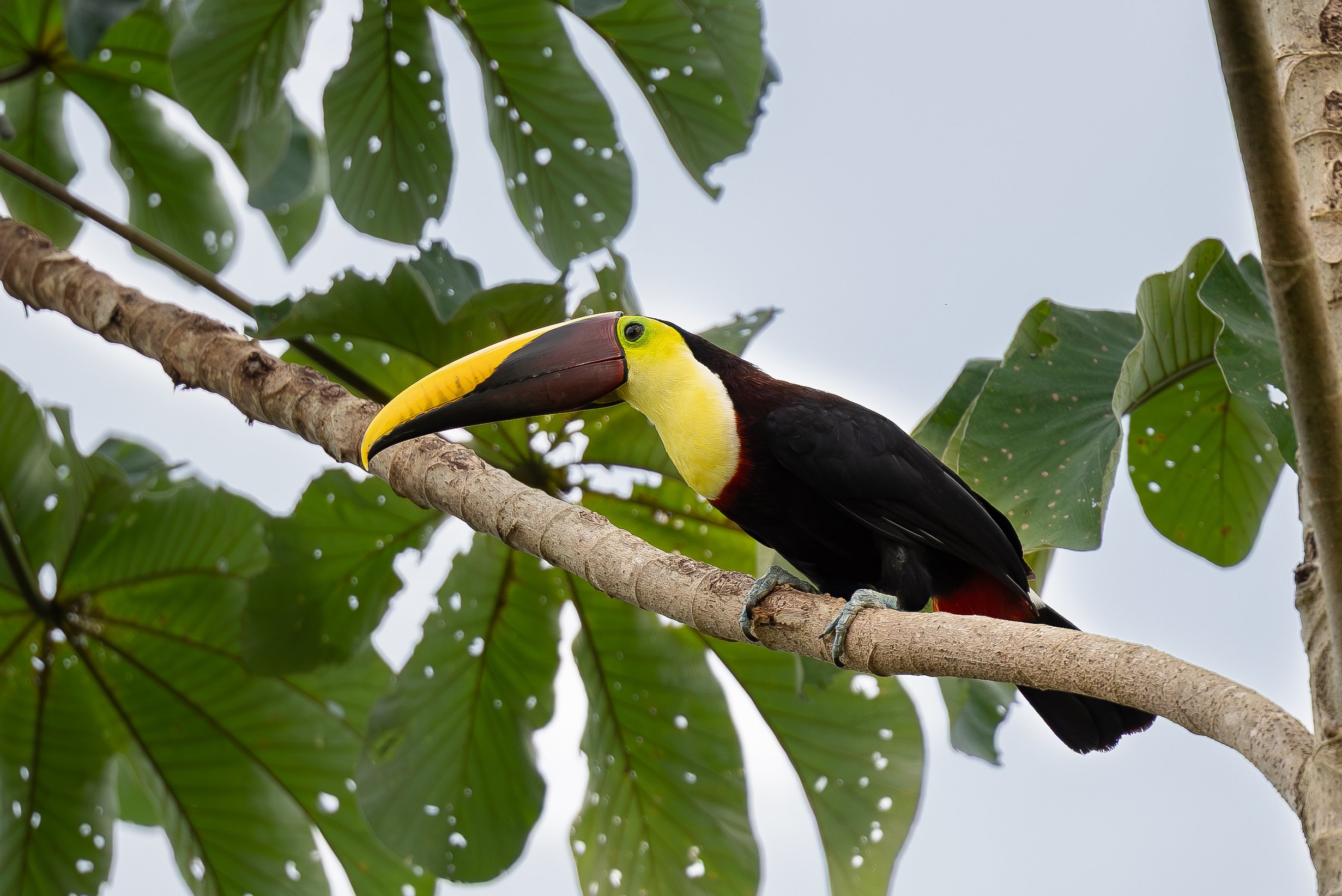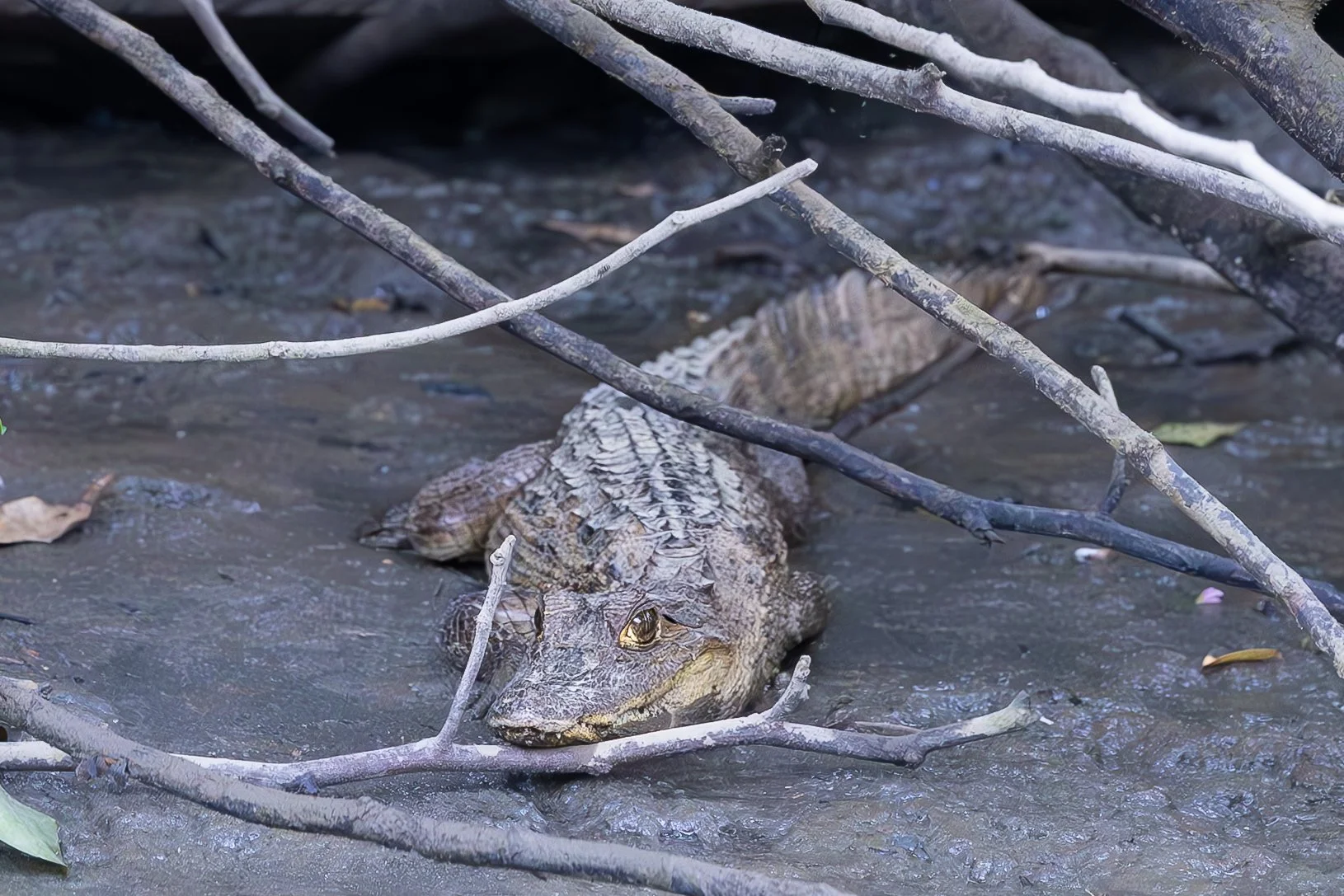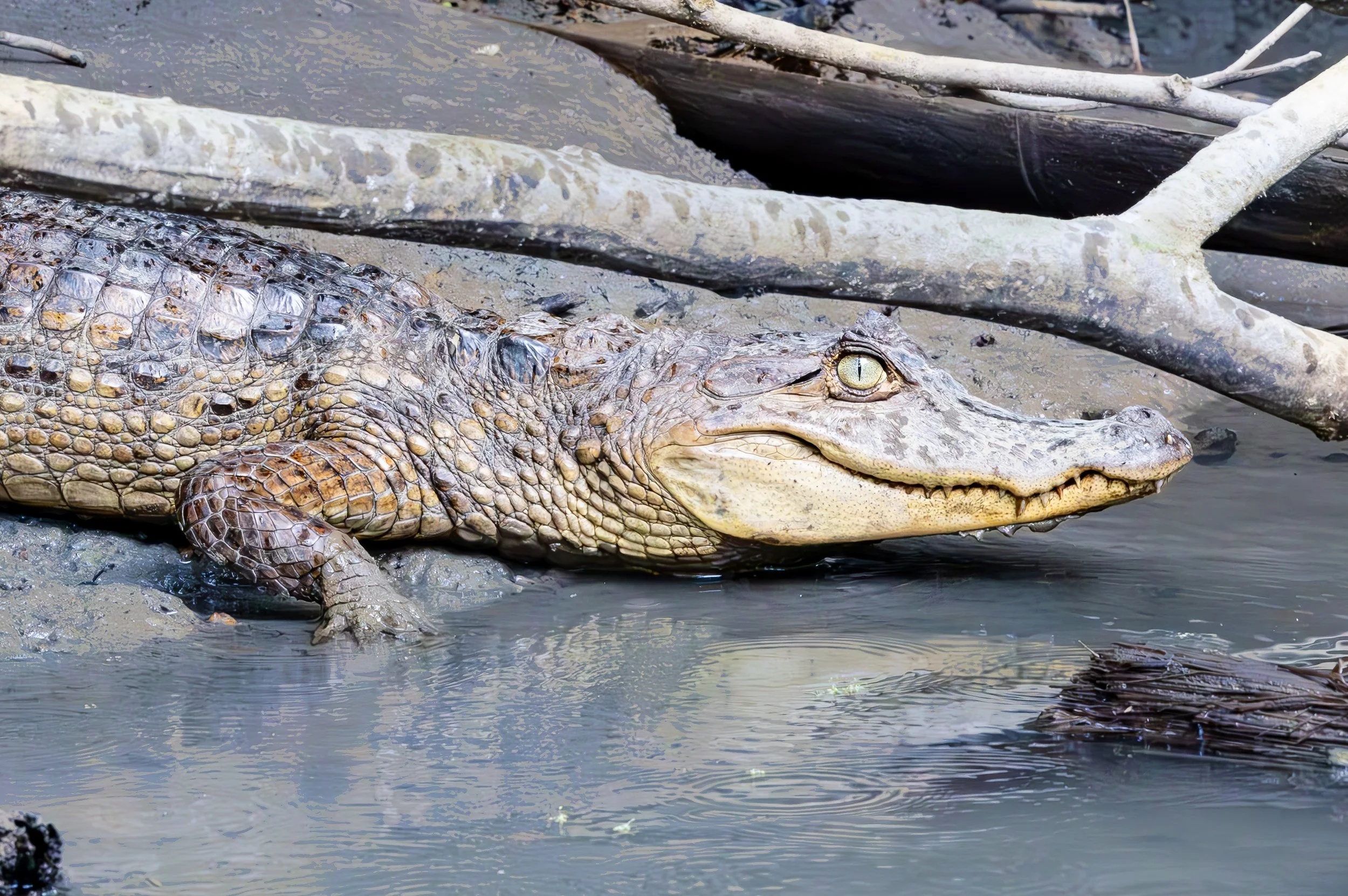
Wildlife Enounters
White-Faced Capuchin Monkey
Also known as Panamanian white-faced capuchins, these mischievous guys are common in Costa Rica and can be found in various habitats like cloud forests, rainforests, and dry forests. They are easily spotted in areas like Manuel Antonio National Park, Osa Peninsula, and Monteverde. These monkeys are known for their agility, intelligence, and curious behavior.
As I cruised along the Sierpe River, I came across dozens of curious monkeys. The Sierpe River lies in one of the most remote parts of Costa Rica, the Osa Peninsula in the south of Puntarenas. This river is surrounded by a lush, mangrove forest. The flora and fauna is some of the most diverse in the country.
Fun Fact: Capuchins form tight-knit social groups and often groom each other not just for cleanliness but to strengthen friendships. If you see one gently picking through another’s fur, you’re basically watching monkey therapy in session.
Howler Monkey
In the lush canopies of Tamarindo, Costa Rica, the howler monkey reigns as the jungle’s alarm clock—though their deep, guttural calls sound more like a dinosaur than a bird. Known for being one of the loudest land animals on Earth, these leaf-munching primates spend most of their day lounging in the treetops, conserving energy for their next round of roaring. Their booming calls can travel up to 3 miles through the forest, serving as a warning to rival troops and a morning wake-up for everyone else. With expressive faces and long, prehensile tails for gripping branches, Costa Rica’s howler monkeys are as much a part of Tamarindo’s charm as the surf and sunsets.
As I ventured to La Leona, a beautiful waterfall hidden in the jungles of Tamarindo, I received the warmest welcome from this baby—an experience I cannot say the same for his brothers on the Caribbean side of Costa Rica.
Fun Fact: These guys have a built-in megaphone — an enlarged hyoid bone in their throat — that lets their morning calls echo through the forest for miles. They’re some of the loudest land animals on Earth, which is impressive considering they spend most of the day just… napping.
The Three-Toed Sloth
Also known ass the Three-fingered sloth, is one of 2 different species found in Costa Rica. Three-toed sloths are arboreal (tree-dwelling) mammals. Large, curved claws and muscles specifically adapted for strength and stamina help sloths to keep a strong grip on tree branches.
The three-toed sloth is most active during early mornings and late afternoon. They live high in the canopy but descend once a week to 💩 on the forest floor. Their long and coarse fur usually appears greenish, this is due to algae growing on it. Sloths will consume the algae growing on their fur, as the algae provides the sloths with carbohydrates and lipids—an additional nutrition source. This algae-green color paired with their sluggish movements provide the perfect camouflage!! They often resemble a bundle of leaves, making them harder to spot in the wild.
Fun Fact: Three-toed sloths are excellent swimmers — they can hold their breath for up to 40 minutes by slowing their heart rate. Imagine crossing the river in slow motion but looking completely zen while doing it.
Two-toed Sloth
The two-toed sloth (Choloepus spp.) is a nocturnal, tree-dwelling mammal found in Central and South America. Despite its name, it has two digits on its forelimbs and three on its hindlimbs, distinguishing it from the three-toed sloth. Larger than its three-toed relative, the two-toed sloth has a more prominent snout, longer fur, and no tail. Adapted for a life spent almost entirely upside down, it moves slowly hand-over-hand through the canopy, conserving energy on a diet of leaves, fruit, and flowers. Known for its deliberate pace, the two-toed sloth is a master of stealth and survival in the treetops.
Spotting one in the wild is rare enough—seeing a two-toed sloth active in daylight is like stumbling onto a secret nature was keeping just for me. Photographing it? That was pure magic.
Fun Fact: Despite their sleepy reputation, two-toed sloths are surprisingly feisty — they have a strong bite and can swing those long arms with some serious power if threatened. They’re the secret MMA fighters of the sloth world.
Daudin’s Vine Snake
Sleek and stealthy, the Daudin’s vine snake is a master of disguise—its slender body and twig-like shape make it almost invisible among branches. Spotting one in the wild feels like uncovering a hidden treasure in the trees.
Upon walking up to the door of my Air BnB in Manzanilo, Costa Rica I was lucky enough to catch a glimpse of this guy—no worries! He’s only mildly venomous! (hehe)
Fun Fact: This snake has a permanent “smirk” thanks to its slightly upturned mouth, making it look cheeky even when it’s perfectly still. It uses its incredible eyesight to hunt during the day — and when threatened, it opens its mouth wide to show off a black-and-white display as if saying, “Back off, I bite!”
Chestnut-mandibled Toucan
One of Costa Rica’s most iconic birds, the Chestnut-mandibled Toucan — also called the Black-mandibled or Swainson’s Toucan — is the largest toucan species in the country. They are found on both the Pacific and Caribbean slopes, often in pairs or small groups, filling the rainforest with their croaking calls (which sound a bit like a frog laughing).
Their massive bill isn’t just for show — it helps them reach fruit, toss it back with precision, and even snatch insects or the occasional lizard. Despite its size, the bill is surprisingly light, made of a honeycomb-like structure.
Found in the backyard of my cabin in Puntarenas, Costa Rica, I woke up to this guy’s beautiful song in the mornings.
Fun Fact: Despite their oversized bills, toucans are surprisingly agile eaters — they toss fruit into the air and catch it with precision, like little circus performers. And that big bill? It doubles as a cooling system, helping them regulate body temperature in Costa Rica’s humid forests.
Collared Aracari
The Collared Aracari is one of the most colorful members of the toucan family — and one of the most mischievous. These small toucans are often spotted in lively groups, hopping through the canopy like a feathered flash mob.
Collared Aracaris are known for their quirky breakfast habits — they sometimes raid other birds’ nests for eggs, proving they’re the cheeky rebels of the toucan world.
I spotted the this festive rebel alongside his chestnut-mandibiled cousin one early morning, as they serenaded me with their competing song.
Fun Fact: These social little toucans often travel in squads of 6–15, chattering loudly as they move. They’ve even been spotted playing what looks like “pass the fruit,” tossing food back and forth before eating it — rainforest dinner party style. They often nest in tree cavities and share them with multiple family members — it’s basically toucan Airbnb up there.
Golden Silk Orb-Weaver
One of the most spectacular web artists of the tropics, this spider spins a web that literally shimmers gold in the sunlight. Found throughout Costa Rica, especially along the Caribbean lowlands, they patiently wait at the center of their massive webs for unsuspecting insects — sometimes even catching small lizards! Their presence is a good sign of a healthy ecosystem, keeping insect populations in check while dazzling travelers with their metallic silk.
Fun Fact: Their silk actually has a golden tint that glows in the sunlight — hence the name. Their webs can be massive (sometimes over a meter wide!) and are built high and strong enough to occasionally catch small birds or bats (though they usually stick to insects). Despite their size and somewhat intimidating look, they are not aggressive and their bite is generally harmless to humans.
Spectacled Caiman
Named for the bony ridge between its eyes that looks like a pair of “spectacles,” this reptile is a patient ambush predator found in rivers, lagoons, and mangroves across Costa Rica. Despite their fearsome look, spectacled caimans are generally shy and prefer to avoid humans — though they’ll happily snap up fish, birds, or the occasional unlucky crab. They play a crucial role in balancing wetland ecosystems, keeping prey populations in check and providing food for scavengers when they leave behind scraps.
Fun Fact: A spectacled caiman’s jaw can snap shut with a bite force of over 1,000 pounds per square inch — that’s strong enough to crush turtle shells like potato chips. Yet, the muscles to open their jaws are so weak that a single strip of tape can keep them shut. Nature really said: “strong closer, weak opener.”
Great Blue Heron
Meet the wetland’s lanky supermodel — the great blue heron. Standing up to 4.5 feet tall with a wingspan wider than most doorways, this bird is all about slow fashion… literally. It hunts by freezing like a statue until the perfect fish swims by, then—bam—spears it with a lightning-fast strike.
They’re expert multitaskers too: they can digest just about anything (frogs, snakes, even small mammals) and still look effortlessly elegant while doing it. And when they take to the skies, they pull their necks into that iconic S-curve, flapping those 6-foot wings like a prehistoric pterodactyl on cruise control.
Fun Fact: great blue herons have specialized neck vertebrae that work like a spring-loaded hinge, letting them whip their heads forward at lightning speed to snatch prey. That’s how they can nail their next meal with deadly accuracy.

